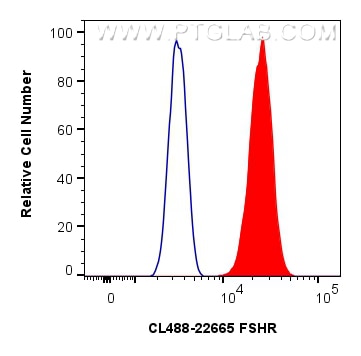Tested Applications
| Positive FC (Intra) detected in | HeLa cells |
Recommended dilution
| Application | Dilution |
|---|---|
| Flow Cytometry (FC) (INTRA) | FC (INTRA) : 0.40 ug per 10^6 cells in a 100 µl suspension |
| It is recommended that this reagent should be titrated in each testing system to obtain optimal results. | |
| Sample-dependent, Check data in validation data gallery. | |
Product Information
CL488-22665 targets FSHR in FC (Intra) applications and shows reactivity with human samples.
| Tested Reactivity | human |
| Host / Isotype | Rabbit / IgG |
| Class | Polyclonal |
| Type | Antibody |
| Immunogen | FSHR fusion protein Ag18158 Predict reactive species |
| Full Name | follicle stimulating hormone receptor |
| Calculated Molecular Weight | 695 aa, 78 kDa |
| Observed Molecular Weight | 71-78 kDa |
| GenBank Accession Number | BC118548 |
| Gene Symbol | FSHR |
| Gene ID (NCBI) | 2492 |
| RRID | AB_3672748 |
| Conjugate | CoraLite®488 Fluorescent Dye |
| Excitation/Emission Maxima Wavelengths | 491 nm / 516 nm |
| Form | Liquid |
| Purification Method | Antigen affinity purification |
| UNIPROT ID | P23945 |
| Storage Buffer | PBS with 50% glycerol, 0.05% Proclin300, 0.5% BSA, pH 7.3. |
| Storage Conditions | Store at -20°C. Avoid exposure to light. Stable for one year after shipment. Aliquoting is unnecessary for -20oC storage. |
Background Information
FSHR, also named as LGR1, belongs to the G-protein coupled receptor 1 family and FSH/LSH/TSH subfamily. FSHR is a receptor for follicle-stimulating hormone. The activity of this receptor is mediated by G proteins which activate adenylate cyclase. Defects in FSHR are a cause of ovarian dysgenesis type 1 (ODG1). Defects in FSHR are a cause of ovarian hyperstimulation syndrome (OHSS). This antibody is specific to FSHR.
Protocols
| Product Specific Protocols | |
|---|---|
| FC protocol for CL488 FSHR antibody CL488-22665 | Download protocol |
| Standard Protocols | |
|---|---|
| Click here to view our Standard Protocols |



